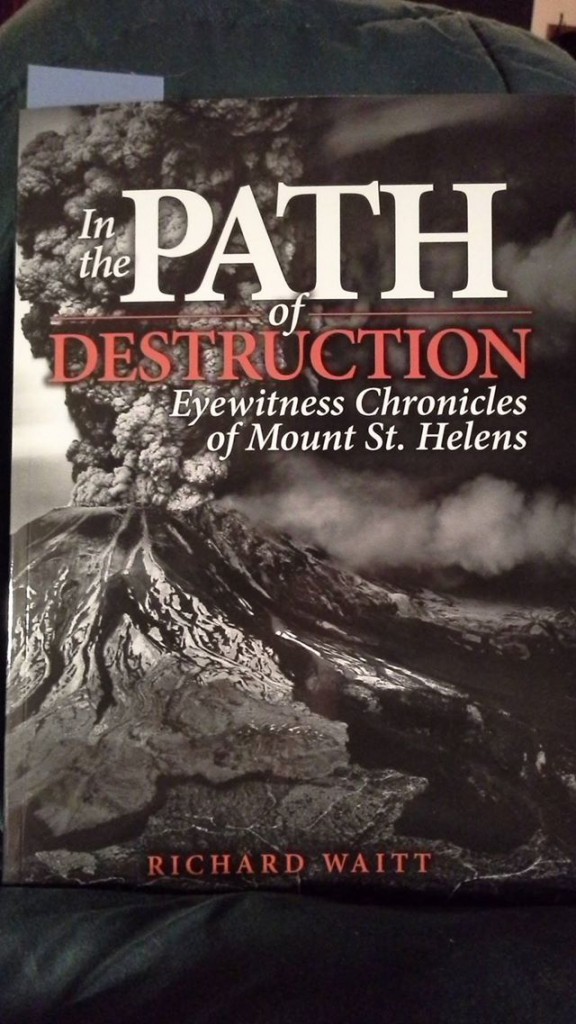This article was published in Scientific American’s former blog network and reflects the views of the author, not necessarily those of Scientific American
Let's continue our volcanic adventures with Richard Waitt's In the Path of Destruction. In this edition: chaos, destruction, and the will to survive.
Chapter 11: North
A mistake that many people make with volcanoes is thinking they're safe at a distance. Most people haven't studied the effects of historical eruptions, or looked at volcanic hazard maps, and aren't prepared when an eruption ignores our ideas of a "safe" distance.
On supporting science journalism
If you're enjoying this article, consider supporting our award-winning journalism by subscribing. By purchasing a subscription you are helping to ensure the future of impactful stories about the discoveries and ideas shaping our world today.
Mike and Lu Moore figured they and their two tiny daughters would be perfectly safe fourteen miles north of Mount St. Helens. After all, there were many 5,000 foot high peaks between them.
But on the morning of May 18th, 1980, they heard a rumble, felt the ground shake, got their ears repeatedly popped by sudden pressure changes, and were abruptly confronted with a wall of ash headed their way. Within minutes, they were in total darkness, trying to shelter in a half-collapsed hunting shack and breathing through damp socks as thick ash fell and thunder crashed.
Mike asks, "Is this what Pompeii was like?"
And the answer is, "No." Inside the devastated area, that was more like Pompeii. But this was close enough for one lifetime.
I already liked Lu and Mike from earlier stories I'd heard of them. They kept their cool, they entertained their four year-old daughter so she wouldn't panic, and protected their infant daughter. They were eminently practical. But I hadn't ever heard that Mike explored the clumps of ash that fell (dry outside, damp inside), the ash outside (cut through, measured it at 1½ to 2 inches thick, noted there were no distinctly-colored layers or pumice), and observed animal and insect tracks in the ash. He coulda been a volcanologist!
They tried to hike out, but they were on the edge of the tree blowdown, and couldn't find a way out that wasn't blocked by fallen trees. They tried several different routes, then calmly camped, waiting for rescue.
(Spoiler alert: They were rescued.)
The moral of so many of these stories is: you can't necessarily predict what nature will do to you. The other moral is: when she does the worst, keep calm and do what you must to survive.
***
Imagine working diligently away, felling trees in a clearcut, when suddenly some of the logs you've just cut start rolling. You turn towards Mount St. Helens, and see a thick black-and-gray cloud boil from the volcano. You see it engulf the area where you know your brother in-law and his wife are. You can't see them die, but you watch the blast cloud that takes their lives advance on you.
Dave Merzoian, Whoop Gould, and their logging crew watched the trees in the distance mow young second-growth fir and enormous old cedar, hemlock, and red fir trees down like blades of grass.
Logger Bob: "What're we gonna do?"
Merzoian: "Get the hell out of here."
Good thinking, that man.
As they made their escape, truck-sized balls of lightning rolled and bounced "across the ground like tumbleweeds." Some of the tough-as-nails lumberjacks started exists crying. Don't judge. If you were caught in that chaos, which looks rather like the end of the world, you might cry too.
They got out safely. Later, they would see that the lateral blast had reached to the edges of their clearcut, felling the standing trees.
A razor-fine line exists between safety and mortal peril.
***
This photo by Gene Palmer is surreal. I can hardly stop staring at it. So, y'know, Gene, if you're reading, message me so we can talk about how I get a print of this on my wall to stare at for more hours.
***
Brian Cole has the official best description of the eruption cloud:
"The cloud grew terrifically, big expanding boily balls."
That's quite the evocative description, there, son.
***
The LaPlaunts, the Westlunds, and Kathie Pierson had been having a lazy camper morning when the mountain blew. They saw a sudden huge line of ground-hugging eruption cloud rear up from behind a ridge.
Everybody: RUN AWAY!!!
They flee, one of the LaPlaunt boys pantless. They drive through a strong wind that makes trees whip and branches crack loose and fly. Thunder, lightning, crashing! A 50,000 foot wall of gray chaos! The heat of the eruption on the back of Mr. Westlund's neck!
They descend the road to Riffe Lake and encounter campers having coffee.
LaPlaunts et al: Mountain go boom!
Campers: It does that.
They continue their flight, leaving the coffee-drinking campers behind. They encounter more campers at the head of the lake, some putting a boat in the water.
Don LaPlaunt: Mountain go boom!
Lady Camper: "Oh, we know."
Mind you, there was still lightning and thunder and such, and mudballs began falling just after. Some people just can't be arsed to disturb their camping Zen for anything.
The LaPlaunts et al made it to safety, all intact. We're not told about the fates of the various campers.
***
That basically completes Chapter 11. There are a couple more stories, but they're like ash, lightning, darkness, done. Aside from one woman mentioning some of the lightning bolts were hot pink, which is just rad, it's pretty basic. And happily, nobody in those statements dies! Woot!
Next, we'll get to Bear Meadow, where some of the most iconic and scientifically important photographs of the entire eruption were taken.

The full list of ITPOD posts is available here. If you want to forge ahead, you can pick up your own copy of In the Path of Destruction here. Purchases through that link help support my blogging, so thank you!
